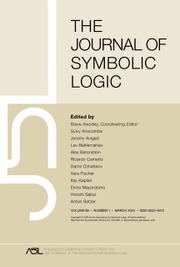Article contents
Embeddability of ptykes
Published online by Cambridge University Press: 12 March 2014
Extract
The notion of a ptyx (plural, ptykes) is obtained by generalising the ordinals On and the dilators Dil introduced by Girard [1] into a typed hierarchy. The notion is due to Girard, and a detailed treatment will appear in Girard [2].
In this Introduction we will give a summary of the theory of ptykes. It will be an advantage to be familiar with the theory of dilators as introduced in Girard [1] or as presented in Girard and Normann [3].
The class On of ordinals is organised into a category ON by using strictly increasing maps f: x → y as morphisms. A dilator will be a functor F: ON → ON commuting with pullbacks and direct limits. Associated with each dilator F there is a denotation system DF, obtained as follows: For each x ∈ On and y ∈ F(x), y can be given a unique denotation (c; x0,…, xn−1;x)F, where c∈F(n) (n = {0,…, n − 1}), y = F(ϕ)(c) (where ϕ is defined by ϕ(i) = xi for i < n), and for no m < n and ψ: m → n do we have c ∈ im(ψ).
We let the trace Tr(F) be the set of pairs (c, n) occurring in a denotation.
Information
- Type
- Research Article
- Information
- Copyright
- Copyright © Association for Symbolic Logic 1992
References
REFERENCES
- 1
- Cited by

